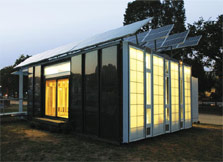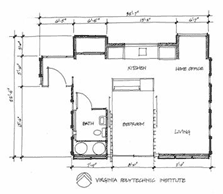

The 2002 Virginia Tech house featured structural elements that save energy and look attractive.
Click drawing to view a larger image.

Solar Decathlon 2002
Virginia Polytechnic Institute and State University
Final Overall Points: 777.901
Final Overall Standing: 5
Winner, Design Presentation and Simulation Contest
Winner, Getting Around Contest
We took a significant stance to celebrate PV and not try to hide it. It's a benevolent umbrella, both a collector of energy and a shading device. It gives the building a strong identity not normally associated with residential buildings.—Robert Dunay, project team advisor
About the Home
The 2002 home designed by Virginia Tech epitomized multifunctionality. Every aspect of the house had more than one purpose, including the solar-electric panels, which produced electrical energy and shaded the home, too. The student-designed Skywall panels, using a translucent aerogel material, insulated the home and let light into the interior. Along the structural south wall, the panels also acted as active solar collectors for domestic hot water and under-floor radiant heating.
Inside the home, the appliances were grouped together on the north wall, and they served as a thermal buffer, retaining extra heat in the winter and venting it to the outside in the summer. A microprism light, typically used for billboards, helped to transfer light evenly throughout the home.
About the Team
The team of architecture, engineering, and industrial design students created a 2002 Solar Decathlon house that successfully combined the three disciplines. The decathletes came to realize that "communication is fundamental," saying that, with different teams in different departments in different colleges, "we could have done a better job at keeping the team informed. If a change took place, we really needed to communicate it to all team members. We came to value the importance of good communication," Robert Schubert, team advisor, reported. After all, one of the hallmarks of a successful union-whether between individuals or among disciplines-is good communication!
The students report that interacting with the sponsors was one of the best parts of their Solar Decathlon experience. Schubert summed up the students' thoughts by saying, "The sponsors have been excellent to work with. We've learned from them and hopefully they've learned from us."
Key Home Features
| Item | Specifics |
|---|---|
| PV kilowatts (standard test condition rating) | 6.00 |
| PV modules | 80 BP Solar BP-275 |
| Charge controllers | 4 Solar Boost 3048 |
| Inverters | 2 Trace SW4048 |
| Battery bank | 1275 ampere-hour, 48 volt |
| Battery type | 20 Concorde PVX-6225 sealed absorbed glass mat |
| Water heating | 140 ft2 (13 m2) of SunEarth absorber plates in custom-built vertical collectors |
| Construction | South, east, and west walls = R15 (RSI 3), north wall = R23 (RSI 4), roof = R31 (RSI 5) |
| Space heating | Ground source heat pump and solar thermal |
| Space cooling | Ground source heat pump |
Manufacturers' Websites
- BP Solar
- Alternative Energy Systems Co. (Solar Boost)
- Xantrex (formerly Trace; Trace charge controllers)
- Concorde
- SunEarth, Inc.
Source: These details have been adapted with permission from Home Power #94, April/May 2003
